



















|
 |
|
 |

The Sauromatae are a people of the horse, and their armies reflect it. The bulk of the Sauromatae are light unarmored horse archers mounted on tough steppe ponies, supported by a heavy lancer corps made up of the nobility of the tribe. Using tactics that have served them and their predecessors for generations, few armies can catch up to and combat effectively a steppe army. In the few cases when infantry is needed, poor tribesmen can fight as skilled foot archers.
Sauromatae Fat Aexsdzhytae (Sarmatian Horse-Archers)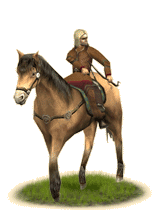 A swarm of nimble, mounted archers riding sturdy steppe ponies is the backbone of most Sarmatian armies and, if adequately handled, they can be a very effective force all by themselves. Most enemies will be slower or have a shorter range. The horse archers can keep peppering them with arrows for hours or days, evading if approached and closing in only when casualties and loss of cohesion have sufficiently weakened their foes. Typical horse archers, however, are not particularly well-suited for hand-to-hand combat. Armour and heavy weapons are expensive and so are the big horses that can deal with the added weight: only nobles and kings can afford such luxuries. Hence, typical horse archers carry little or no armour and are likely to suffer if forced into melee against most adversaries. A swarm of nimble, mounted archers riding sturdy steppe ponies is the backbone of most Sarmatian armies and, if adequately handled, they can be a very effective force all by themselves. Most enemies will be slower or have a shorter range. The horse archers can keep peppering them with arrows for hours or days, evading if approached and closing in only when casualties and loss of cohesion have sufficiently weakened their foes. Typical horse archers, however, are not particularly well-suited for hand-to-hand combat. Armour and heavy weapons are expensive and so are the big horses that can deal with the added weight: only nobles and kings can afford such luxuries. Hence, typical horse archers carry little or no armour and are likely to suffer if forced into melee against most adversaries.
Historically, life as nomadic herders on the steppe produced highly skilled bowmen and riders who could put those abilities to very good use on a battlefield. For over two millennia, these warriors were levied from the diverse nomads that roamed the vast Eurasian steppe and were a central and iconic component of their armies. Horse archer armies relied on mobility (at the strategic and tactical levels) and their excellent composite bows to win their battles and wars and their victories could be truly devastating. Both Macedonians and Romans at the peak of their military power saw some of their armies totally annihilated by enemies relying on horse archers and steppe tactics.
Sauromatae Arc Aexsaeg (Sarmatian Light Spearmen)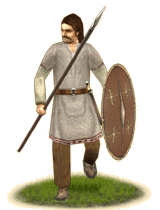 Sarmatian Spearmen are raised from settled groups of formerly nomadic Sarmatians such as the Siracae of Ciscaucasia. As they abandon their traditional way of life as nomadic herdsmen, more and more of their warriors become infantry. The equipment of these troops reflects substantial Greek influence, which is quite evident in, for example, the large oval shields of the thureos type that these infantrymen carry. That shield is typically their only protection. To it, they add spears and short swords for offense. Thanks to their shields, they may face the many archers that their potential enemies are likely to field with some confidence and their spears allow them to fend off the light cavalry that is also common among their foes. They will also hold their ground against infantry similar to themselves. However, truly heavy cavalry, not to speak of quality heavy infantry will get the better of them sooner rather than later. Sarmatian Spearmen are raised from settled groups of formerly nomadic Sarmatians such as the Siracae of Ciscaucasia. As they abandon their traditional way of life as nomadic herdsmen, more and more of their warriors become infantry. The equipment of these troops reflects substantial Greek influence, which is quite evident in, for example, the large oval shields of the thureos type that these infantrymen carry. That shield is typically their only protection. To it, they add spears and short swords for offense. Thanks to their shields, they may face the many archers that their potential enemies are likely to field with some confidence and their spears allow them to fend off the light cavalry that is also common among their foes. They will also hold their ground against infantry similar to themselves. However, truly heavy cavalry, not to speak of quality heavy infantry will get the better of them sooner rather than later.
Historically, by the 3rd century BC oval shields with long spines and spindle-shaped bosses spread and became common into the areas around the north coast of the Black Sea. The whole region had long maintained strong connections with the Greek world and this particular process followed military developments in the Hellenistic world. Infantry men equipped with oval shields and spears became common among the diverse ethnic groups that inhabited the region including settled Sarmatian tribes.
Sauromatae Fistaeg Fat Aexsdzhytae (Sarmatian Foot Archers)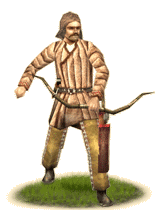 Unlike most other Sarmatians, many of the bowmen from Sarmatian groups that have become settled do not shoot their arrows from horseback, but fight on foot. Certainly, foot archers lack the mobility of their mounted counterparts. In exchange, men on foot need less space than those on horseback. Thus, foot archers can be deployed in tighter formations that provide heavier arrow barrages. And the composite bows that these foot archers employ maintain still the qualities of those of their nomadic relatives. Unlike most other Sarmatians, many of the bowmen from Sarmatian groups that have become settled do not shoot their arrows from horseback, but fight on foot. Certainly, foot archers lack the mobility of their mounted counterparts. In exchange, men on foot need less space than those on horseback. Thus, foot archers can be deployed in tighter formations that provide heavier arrow barrages. And the composite bows that these foot archers employ maintain still the qualities of those of their nomadic relatives.
Historically, several groups of Sarmatians became sedentary when they moved into areas (Ciscaucasia, the Hungarian Plain, etc.) where farming was a viable option to their traditional pastoral nomadism. The Siracae, for example, were a relatively small Sarmatian group that occupied the southern edges of the steppe along the Black Sea and in Ciscaucasia. Since quite early, they initiated a process of settlement and hellenization and, while still fielding armies with numerous cavalry, they resorted to infantry most than any other Sarmatians in the centuries BC. Presumably, the abundance of horsemen may have not been the only trace that steppe warfare left upon the ways of waging war of settled Sarmatians and substantial numbers of their infantry seem to have been archers using composite bows.
Skuda Fat Aexsdzhytae (Scythian Horse-Archers)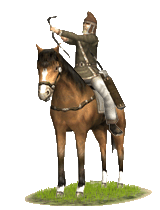 Scythian Horse Archers are not different to their many counterparts in their approach to battle. Only lightly protected and often with little more than a short sword as melee weapon, they rely instead in the power of their excellent composite bows and the speed and endurance of their sturdy steppe horses (and possibly the use of remounts). With these tools, they torment foes that cannot catch them or shoot back (or are outranged) with arrows until mounting casualties, exhaustion, sheer frustration and, perhaps, a rightly-timed charge by the core of heavier cavalry that often accompanies the horse archers, bring about the collapse of the enemy. Then, they will be eager to join in the pursuit and, thanks again to the speed of their mounts, they will be ruthlessly efficient in this task as well. Routing foes pursued by them have only very slim chances of escaping. As a part of a combined-arms army, they can harass an enemy, disrupt its formations and, with feigned flights, lure their troops to cunning ambushes. A judicious commander will seek to benefit from the strengths of Scythian Horse Archers and to minimize their weaknesses by deploying them in loose formations, in terrain that does not hamper their movement and by wisely keeping them out of hand-to-hand combat until the time is right. Scythian Horse Archers are not different to their many counterparts in their approach to battle. Only lightly protected and often with little more than a short sword as melee weapon, they rely instead in the power of their excellent composite bows and the speed and endurance of their sturdy steppe horses (and possibly the use of remounts). With these tools, they torment foes that cannot catch them or shoot back (or are outranged) with arrows until mounting casualties, exhaustion, sheer frustration and, perhaps, a rightly-timed charge by the core of heavier cavalry that often accompanies the horse archers, bring about the collapse of the enemy. Then, they will be eager to join in the pursuit and, thanks again to the speed of their mounts, they will be ruthlessly efficient in this task as well. Routing foes pursued by them have only very slim chances of escaping. As a part of a combined-arms army, they can harass an enemy, disrupt its formations and, with feigned flights, lure their troops to cunning ambushes. A judicious commander will seek to benefit from the strengths of Scythian Horse Archers and to minimize their weaknesses by deploying them in loose formations, in terrain that does not hamper their movement and by wisely keeping them out of hand-to-hand combat until the time is right.
Historically, the Scythians were largely responsible of first impressing on the minds of the settled peoples the image of the wild, steppe horse archer visiting destruction upon civilization. To some extent, they were preceded in this by the Cimmerians, but the extent and consequences of the Cimmerian invasions, large as they were, did not reach the scale of widespread devastation associated with the Scythians. In the 7th century BC after having subdued Media for some time and having contributed to the definitive fall of the Assyrian Empire, the Scythians poured over Mesopotamia, Western Asia Minor and the Near East ravaging and plundering as they went. Before crossing back the Caucasus and returning to the steppes, they would reach the very doors of Egypt, where Pharaoh Psammetichos paid a heavy tribute to see them depart. They wreaked major havoc that has left a diversity of lasting memories. The texts of the prophet Jeremiah in the Bible, the many Scythian trilobate arrowheads of cast bronze stuck in the brick walls of burnt cities over a very wide area, the writings of Herodotus or the city named Scythopolis (modern Beth-Shean in Israel) are some of the most conspicuous ones. Later, in the 6th century BC, Darius I, Great King of the Achaemenid Persian Empire, would claim retribution from past wrongs as the reason for his invasion of Scythian lands in the northern Black Sea coast. The invasion ended up in failure. Herodotos' account of that campaign is a textbook example (possibly the first recorded instance) of the application of the strategic retreat and scorched earth tactics and of the difficulties and dangers associated to fighting steppe nomads in their home turf.
Skuda Fistaeg Fat Aexsdzhytae (Scythian Foot Archers)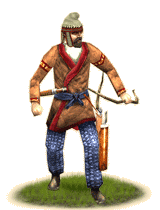 These Skythian archers often carry a slightly larger version of the composite bow that their fellow cavalrymen employ. This fact, together with the advantage of shooting from a more stable platform than a moving horse, tends to give their missiles somewhat longer range and more power than those typically shot by horse archers. To some extent, they compensate in this way for their comparative lack of mobility. Certainly, substantial numbers of foot bowmen can make sure that horse archers stay away from the area of the battlefield where they are deployed or inflict substantial damage on them, should they be foolish enough to engage in a protracted missile exchange. Of course, they will not be able to catch and destroy the elusive riders if the latter decide to avoid the arrow duel. In that regard, it is important that these archers are not lured too far away from supporting heavier infantry or cavalry whether in the pursuit of horse archers or for any other reason. They are not well outfitted for hand to hand combat, as all they carry is a short sword or small pickaxe and no armor but their thick jackets and bashlyk felt caps. If unsupported, they will be easy prey for cavalry, or aggressive infantry fast enough to catch them. These Skythian archers often carry a slightly larger version of the composite bow that their fellow cavalrymen employ. This fact, together with the advantage of shooting from a more stable platform than a moving horse, tends to give their missiles somewhat longer range and more power than those typically shot by horse archers. To some extent, they compensate in this way for their comparative lack of mobility. Certainly, substantial numbers of foot bowmen can make sure that horse archers stay away from the area of the battlefield where they are deployed or inflict substantial damage on them, should they be foolish enough to engage in a protracted missile exchange. Of course, they will not be able to catch and destroy the elusive riders if the latter decide to avoid the arrow duel. In that regard, it is important that these archers are not lured too far away from supporting heavier infantry or cavalry whether in the pursuit of horse archers or for any other reason. They are not well outfitted for hand to hand combat, as all they carry is a short sword or small pickaxe and no armor but their thick jackets and bashlyk felt caps. If unsupported, they will be easy prey for cavalry, or aggressive infantry fast enough to catch them.
Along their history, the Skythians of the northern coast of the Black Sea underwent a process of settlement and sedentarization. The phenomenon had started quite early, as Herodotos already spoke of farming Skythian groups, but it seems to have picked up pace as Sarmatian pressure pushed the Skythians out from much of their former lands and restricted them to a much reduced territory (the western part of the Crimea and the lower Dniepr) that could not have supported a large nomadic population. This process resulted in Skythian armies fielding increasing numbers of foot troops. A good portion of those seem to have been bowmen, as many settled Skythians still favored their traditional weapon.
Skuda Baexdzhyntae (Scythian Riders)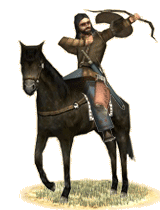 These light riders are from the Scythian tribes to the north of the Pontus Euxine (Black Sea). They rely on a long spear, bow and shield (typically, the crescent shaped, leather faced, Taka shield of the Scythian peoples) and are some of the most effective light horse available. There is also the long sword typical of the nomads, a Scytho-Sarmatian weapon with a ring-pommel. They are at their best when fighting in loose open formations, harassing the enemy, but ready in an instant to descend like lightning on any foe rendered vulnerable. Against unbroken infantry these light horsemen will prove of little value in a hand to hand clash and care should be taken not to waste them in such a way. These light riders are from the Scythian tribes to the north of the Pontus Euxine (Black Sea). They rely on a long spear, bow and shield (typically, the crescent shaped, leather faced, Taka shield of the Scythian peoples) and are some of the most effective light horse available. There is also the long sword typical of the nomads, a Scytho-Sarmatian weapon with a ring-pommel. They are at their best when fighting in loose open formations, harassing the enemy, but ready in an instant to descend like lightning on any foe rendered vulnerable. Against unbroken infantry these light horsemen will prove of little value in a hand to hand clash and care should be taken not to waste them in such a way.
Historically, during the 6th Century BC Persian invasion, the Scythian cavalry swept ahead of the invaders destroying anything of use to them. They led a Royal Achaemenid army into a futile chase across the steppe until overstretched Persian supply lines and scorched-earth tactics allowed them to turn from pursued into pursuers. The mauled Persian army managed to avoid destruction and regain the safe South bank of the Danube, but the Scythians had borne the brunt of Achaemenid might and had remained unconquered and masters of their lands. Also, even in their decline, they totally destroyed a 30,000 strong army sent by Zopyrion, one of Alexander’s generals, in 331 BC
Aursa Baexdzhyntae (Aorsi Riders)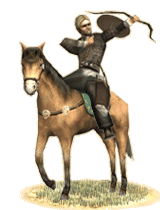 The Aursa Baexdzhyntae (Aorsi Riders) are the base of the armies fielded by the Aorsi, one of several major Sarmatian groups. Aorsi Riders are first and foremost horse archers, but, on average, Aorsi tribesmen are somewhat better equipped than their counterparts from other, earlier Sarmatian tribes. Thus, they often wear a measure of simple armor and tend to carry spears in addition to their bows. Hence, they can give a slightly better account of themselves if they find themselves engaged in hand-to-hand combat. Not that they will actively seek it, however. At least not against enemies whom archery fire, feigned retreats and sudden false charges have not thrown yet into utter confusion and demoralization. The Aursa Baexdzhyntae (Aorsi Riders) are the base of the armies fielded by the Aorsi, one of several major Sarmatian groups. Aorsi Riders are first and foremost horse archers, but, on average, Aorsi tribesmen are somewhat better equipped than their counterparts from other, earlier Sarmatian tribes. Thus, they often wear a measure of simple armor and tend to carry spears in addition to their bows. Hence, they can give a slightly better account of themselves if they find themselves engaged in hand-to-hand combat. Not that they will actively seek it, however. At least not against enemies whom archery fire, feigned retreats and sudden false charges have not thrown yet into utter confusion and demoralization.
Historically, the Aorsi were one of the most powerful Sarmatian confederacies. Though almost certainly a major exaggeration, Strabo credited the smaller of their two subdivisions with the capability of fielding an army of 200,000 riders. Also, graves ascribed to the Aorsi by the archaeologists attest to a certain prosperity and tend to be relatively well-equipped. In any case, their dominions extended east as far as the Caspian, or, probably, even the Aral Sea. In the west, they occupied the steppe between the Volga and Don rivers for a long time. Eventually, they moved west beyond the Don, pushed perhaps by the emergence of the Alans who might have absorbed or conquered many of them.
Rauxsa-alanna Baexdzhyntae (Roxolani Riders)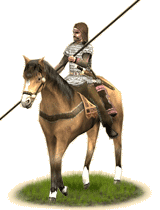 Lancers represent a shift of emphasis in Sarmatian warfare from mounted archery and attrition towards furious charges and shock combat. Equipped with the kontos, a long lance over 4 m long that they wield two-handed, and wearing good scale armour, Roxolani Riders can deliver a charge that few foes, mounted or foot, can withstand. A solid wall of pike or spear points will still be largely immune to such frontal attacks. However, many horse archers still fight alongside the lancers and the lancers themselves carry bows and are adept at the feigned flight and all the other steppe manoeuvres that can throw an enemy into disorder. In addition to kontos, bow and scale armour, a longsword completes the lancer’s panoply. Lancers represent a shift of emphasis in Sarmatian warfare from mounted archery and attrition towards furious charges and shock combat. Equipped with the kontos, a long lance over 4 m long that they wield two-handed, and wearing good scale armour, Roxolani Riders can deliver a charge that few foes, mounted or foot, can withstand. A solid wall of pike or spear points will still be largely immune to such frontal attacks. However, many horse archers still fight alongside the lancers and the lancers themselves carry bows and are adept at the feigned flight and all the other steppe manoeuvres that can throw an enemy into disorder. In addition to kontos, bow and scale armour, a longsword completes the lancer’s panoply.
Historically, even the first armies of horse archers that emerged from the steppe probably contained a core of heavy cavalry. In this regard, the appearance and spread of armoured riders wielding a long, two-handed lance represented an innovation in steppe warfare more because the specialization of their equipment and their greater numbers than by being a radically new concept. For the Sarmatians in particular, these lancers were a relatively late development. Their first traces come from the Volga area in the 3rd and 2nd centuries BCE, but the troop type does not seem to have spread westwards for at least another two centuries. Moreover, the lancers proved to be a very effective complement of the horse archers, but they never completely superseded them. Nonetheless, Sarmatian armoured lancers made an indelible impression upon Greek and Roman witnesses and eventually became the archetypical Sarmatian image.
Skuda Uaezdaettae (Scythian Noble Cavalry)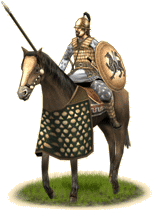 Although no longer the epitome of nomadic military ardor, the remnants of the Skythian nobility still serve as a powerful cavalry force. Now, the Skuda Uaezdaettae, or Skythian Nobles, fight in a matter almost more similar to the Greeks than their nomadic ancestors, preferring the xyston or spear and sword to archery, even though they still carry composite bows. Equipped with a fine lynothorax reinforced with metal scales, long pteryges and a Greek style bronze helmet, they can still form a deadly cavalry force, though not to the extent they once could. Their tactics have also shifted to deal more with similarly equipped cavalry and heavy infantry rather than nomadic horse archers. Although no longer the epitome of nomadic military ardor, the remnants of the Skythian nobility still serve as a powerful cavalry force. Now, the Skuda Uaezdaettae, or Skythian Nobles, fight in a matter almost more similar to the Greeks than their nomadic ancestors, preferring the xyston or spear and sword to archery, even though they still carry composite bows. Equipped with a fine lynothorax reinforced with metal scales, long pteryges and a Greek style bronze helmet, they can still form a deadly cavalry force, though not to the extent they once could. Their tactics have also shifted to deal more with similarly equipped cavalry and heavy infantry rather than nomadic horse archers.
Historically, after the Sauromatae began to invade their territory, the Skythians began to decline. Each year they shrunk, until they only continued in what became known as "Skythia Minor", the lower Dniepr and the Crimea. Because of this, their conections to the Hellenistic Black Sea colonies, which were always strong grew even greater until many Skythians were settled and resembled Greeks more than their nomadic cousins still on the steppe. Even so, they never completely lost their skill with cavalry and their martial prowess and under the rule of King Skiluros the Crimean Skythians experienced a revival of their fortunes. They gained control of the Greek city of Olbia and fought successfully against the Bosporan Kingdom. However, this prompted the intervention of a Pontic Kingdom that, under a young Mithradates VI was starting an agressive expansion. Pontic forces defeated the Skythians and made them vassals of Pontos. As such, they would become a very valuable asset for the Pontic army in its subsequent wars with Rome.
Rauxsa-alanna Uaezdaettae (Roxolani Noble Cavalry)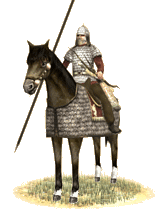 If many Roxolani riders can now equip themselves with corselets of scale armor, their nobility will take this trend one step further and provide defenses for the horses they ride as well. Protecting their mounts represents a substantial advantage for horsemen expected to charge headlong into the enemy, as horses, being a large target, are particularly vulnerable to missiles. In addition, when both horse and rider are armored, their momentum increases and their potential impact is greater. Thus, the charge of a group of Roxolani nobles is truly terrible and will often succeed in punching a hole in an enemy battle line that the rest of the warriors will be able to exploit. This does not mean that they constitute any of sort of “forlorn hope” or are particularly suicidal. Typically, they will first probe for weaknesses and, if none are readily found, they will work to create them. For such a task they may well resort to their bows, using archery to “soften” a spot prior to a charge. For an astute commander, they are a very valuable resource which should not be lightly squandered. If many Roxolani riders can now equip themselves with corselets of scale armor, their nobility will take this trend one step further and provide defenses for the horses they ride as well. Protecting their mounts represents a substantial advantage for horsemen expected to charge headlong into the enemy, as horses, being a large target, are particularly vulnerable to missiles. In addition, when both horse and rider are armored, their momentum increases and their potential impact is greater. Thus, the charge of a group of Roxolani nobles is truly terrible and will often succeed in punching a hole in an enemy battle line that the rest of the warriors will be able to exploit. This does not mean that they constitute any of sort of “forlorn hope” or are particularly suicidal. Typically, they will first probe for weaknesses and, if none are readily found, they will work to create them. For such a task they may well resort to their bows, using archery to “soften” a spot prior to a charge. For an astute commander, they are a very valuable resource which should not be lightly squandered.
Historically, only the richest Sarmatian chieftains were able to furnish complete sets of defensive equipment for both themselves and their horses. However, the impact, at least psychological, of such superbly equipped riders upon their enemies seems to have been much greater than what their numbers alone might have led to expect. Often, depictions of Sarmatians in battle produced by their enemies show masses of armoured horsemen. Archaeology and other sources indicate that this is a major overstatement, but such representations still probably hint about what most durably impressed the foes of the Sarmatians.
Ragon Sauromatae Uaezdaettae (Sarmatian Noble Horse-Archers)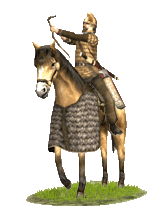 Sarmatian nobles are among the few in their society that can actually afford the very high costs of reasonably good defensive gear and of the larger horses which are able to carry a rider wearing such heavy equipment. Those expenses pay off by conferring them the ability to engage in hand-to-hand combat with some guaranties and, not to be forgotten, better looks than their less wealthy fellows. Nonetheless, in the early stages of the Sarmatian culture, even nobles carry only limited amounts of armour and are better thought of as medium or even light cavalry. Fortunately, they can still rely on their archery skills, in no way inferior to those of any other Sarmatian warrior and, although modest, the improvement in their equipment does allow them to carry out certain special tasks. Thus, they can fight enemy light cavalry with good prospects of victory. They can deal with enemy horse archers by either winning archery duels with them (thanks to their better armor) or by chasing them and beating them in melee (if they manage to catch them). They can also accelerate the collapse of enemy infantry still in relatively good shape through rear or flank charges and take good care of foot skirmishers. However, they are not prepared to frontally charge any decent close order infantry. Sarmatian nobles are among the few in their society that can actually afford the very high costs of reasonably good defensive gear and of the larger horses which are able to carry a rider wearing such heavy equipment. Those expenses pay off by conferring them the ability to engage in hand-to-hand combat with some guaranties and, not to be forgotten, better looks than their less wealthy fellows. Nonetheless, in the early stages of the Sarmatian culture, even nobles carry only limited amounts of armour and are better thought of as medium or even light cavalry. Fortunately, they can still rely on their archery skills, in no way inferior to those of any other Sarmatian warrior and, although modest, the improvement in their equipment does allow them to carry out certain special tasks. Thus, they can fight enemy light cavalry with good prospects of victory. They can deal with enemy horse archers by either winning archery duels with them (thanks to their better armor) or by chasing them and beating them in melee (if they manage to catch them). They can also accelerate the collapse of enemy infantry still in relatively good shape through rear or flank charges and take good care of foot skirmishers. However, they are not prepared to frontally charge any decent close order infantry.
Historically, the noble elite of the steppe nomads was able to afford better equipment for war and, thus, provided their armies with a core of heavier cavalry capable of hand-to-hand combat. How many of the nomads could afford the better gear and its amount and quality, depended on the wealth and access to resources such as mineral ore of each nomad group. Consequently, it varied substantially in space and time. In the particular case of the Ancient Sarmatian Culture, archaeological and literary sources suggest than metal armour was quite rare.
Aursa Uaezdaettae (Aorsi Noble Cavalry)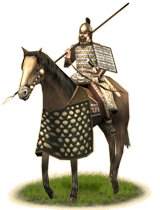 As is usual for most steppe nomads, nobility among the Aorsi have the means to equip themselves with more and better war gear than their followers. Metal armour, nonetheless, is still beyond the means of most Aorsi nobles and they must be content with either polished horn or hardened leather. Modest as they may initially seem, those materials confer nonetheless enough protection that Aorsi nobles may face a diversity of foes in hand-to-hand combat and expect to come out the victors. Their charges pack a distinct punch and their armour allows them to withstand both distant archery and melee against lightly armed foes reasonably well. However, they cannot expect to frontally charge infantry that has not been “softened” or to engage truly heavy cavalry and survive. Of course, true to steppe traditions, Aorsi nobles have not forsaken the composite bow and against such heavier enemies their skill as bowmen serves them very well. As is usual for most steppe nomads, nobility among the Aorsi have the means to equip themselves with more and better war gear than their followers. Metal armour, nonetheless, is still beyond the means of most Aorsi nobles and they must be content with either polished horn or hardened leather. Modest as they may initially seem, those materials confer nonetheless enough protection that Aorsi nobles may face a diversity of foes in hand-to-hand combat and expect to come out the victors. Their charges pack a distinct punch and their armour allows them to withstand both distant archery and melee against lightly armed foes reasonably well. However, they cannot expect to frontally charge infantry that has not been “softened” or to engage truly heavy cavalry and survive. Of course, true to steppe traditions, Aorsi nobles have not forsaken the composite bow and against such heavier enemies their skill as bowmen serves them very well.
Historically, Aorsi warfare remained firmly based on the horse archery tradition. Nonetheless, they, particularly their noble elite, also appear to have been somewhat better prepared for melee combat than earlier groups of Sarmatian peoples. It is not unconceivable that against more poorly equipped enemies they may have not been content with just winning archery duels thanks to their greater protection and may have actively sought to close in, so advantages in hand-to-hand offensive equipment may also be put to good use.
Aeldary Aembaltae (Sarmatian Bodyguard Cavalry)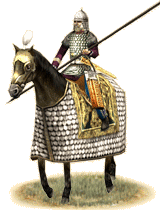 The retainers of a Sarmatian warlord of the royal family have, like their master, access to the very best in terms of arms, armour and horses. In consequence, they are typically the warriors best equipped for hand-to-hand combat within a Sarmatian army, often the only ones, and, as such, their intervention at critical points of a battle may well decide its outcome. However, not even a Sarmatian prince may afford keeping a large retinue and hence, these select warriors are few in number. Therefore, it is imperative that they are judiciously used and committed only when and where they can really tip the balance of a fight. The retainers of a Sarmatian warlord of the royal family have, like their master, access to the very best in terms of arms, armour and horses. In consequence, they are typically the warriors best equipped for hand-to-hand combat within a Sarmatian army, often the only ones, and, as such, their intervention at critical points of a battle may well decide its outcome. However, not even a Sarmatian prince may afford keeping a large retinue and hence, these select warriors are few in number. Therefore, it is imperative that they are judiciously used and committed only when and where they can really tip the balance of a fight.
Historically, Sarmatian nobles maintained a number of retainers, providing them with equipment and, possibly, some means of sustenance. In turn, those retainers followed their lord whenever he went to war. The richer the noble or chieftain, the better equipped his retinue, the extreme being those warriors that constituted the guard of members of royal families. Thus, while a lesser chieftain may be surrounded by just some light horse archers, a Sarmatian prince led a group of armoured riders wielding the finest weaponry. Friendship was highly valued among the Sarmatians and was often expressed in oaths of mutual loyalty between warriors which further enhanced the cohesion of such groups. The battlefield impact of such well equipped and highly motivated unit, even if they were not numerous, should not be lightly dismissed.
Voinu (Slavic Light Spearmen)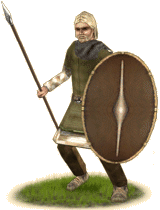 Voinu are fierce infantry spearmen who form the bulk of the armies of the Neuri and Boudinoi. They wear no armor, but their large, oval shields afford substantial protection and they are brave, wild warriors that make very tough opponents. In addition, they inhabit harsh terrain, forest, rivers and swamps, which is not suitable for cavalry warfare, but that they can use to their advantage. Therefore, their tactical doctrine was probably similar to that of their later descendants, the Central European Slavs, who lived and fought under similar conditions: the deployment of spearmen defended by big shields and backed by packs of skirmishers armed with sturdy bows. When in a favorable ground, the wild courage of these tribesmen and their terrifying reputation (the claims of their being cannibals appear to have had a solid basis) are added to the picture, the resulting combination is one than can prove very difficult to defeat. Voinu are fierce infantry spearmen who form the bulk of the armies of the Neuri and Boudinoi. They wear no armor, but their large, oval shields afford substantial protection and they are brave, wild warriors that make very tough opponents. In addition, they inhabit harsh terrain, forest, rivers and swamps, which is not suitable for cavalry warfare, but that they can use to their advantage. Therefore, their tactical doctrine was probably similar to that of their later descendants, the Central European Slavs, who lived and fought under similar conditions: the deployment of spearmen defended by big shields and backed by packs of skirmishers armed with sturdy bows. When in a favorable ground, the wild courage of these tribesmen and their terrifying reputation (the claims of their being cannibals appear to have had a solid basis) are added to the picture, the resulting combination is one than can prove very difficult to defeat.
Historically, Herodotos wrote about the Neuri and Boudinoi and placed them as northern neighbours of the European Scythians. Nowadays, many historians think they occupied the swamps and forests of Prippet and the upper Dnieper and associate them with advanced archeological cultures of the area. Features of those cultures are the use of iron weapons and a substantial influence from their southern Scythian neighbours. Some scholars consider the Neuri and Boudinoi the earliest known ancestors of the Proto-Slavs. In that case, their warrior class would have been plausibly called "Voinu", a proto-slavic word for "Warrior". In any case, they were fierce and wild opponents and cannibalism was apparently not foreign to them. Markings of teeth on human bones have been found in excavations and Herodotos wrote of the Androphagoi, the man-eaters. They are possibly the basis of the evil werewolves, man-eating wolf-people of later Slavic legend. In the historical past, whoever fought those tribes knew what terrible fate would befall them if they lost.
|
 |
|
 |






















|